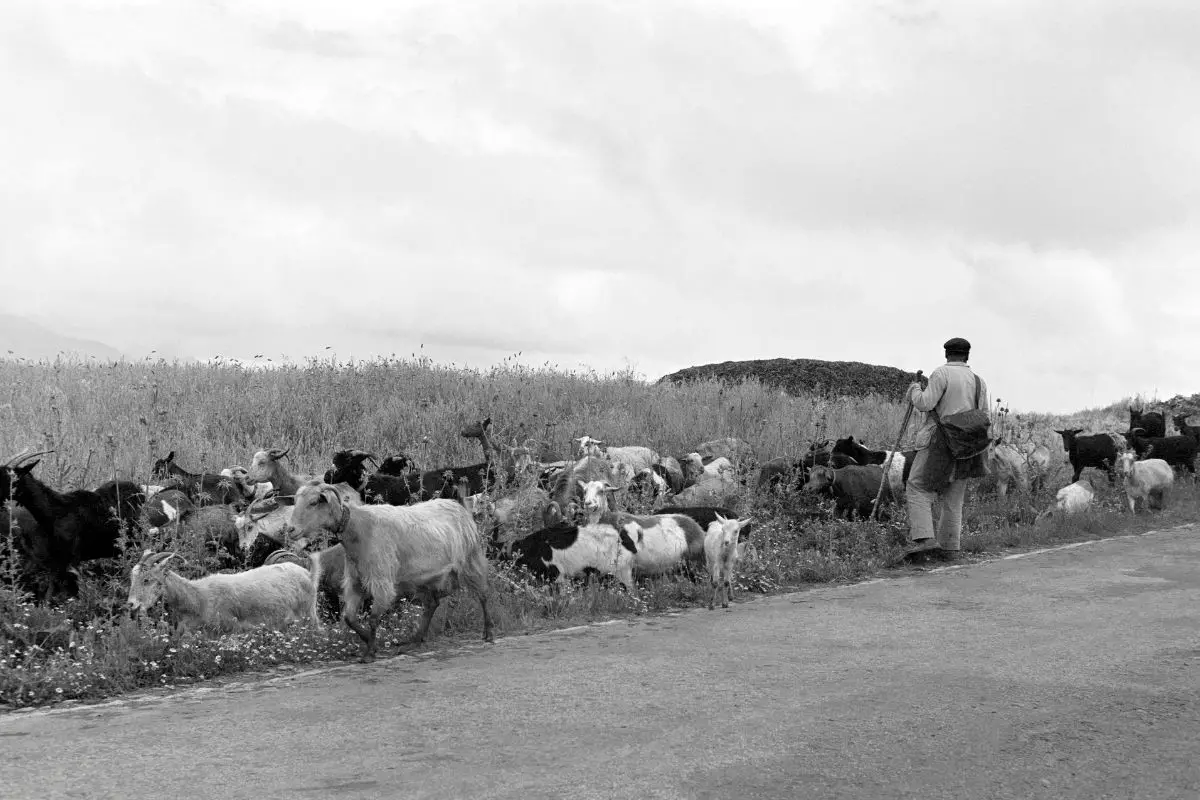In this article, you will learn about Kaldi, a goat herder in 9th-century Ethiopia, who is believed to have discovered coffee’s energizing effects after observing his goats’ unusual behavior after consuming mysterious red berries. The article discusses the historical records mentioning Kaldi, as well as his experimentations with the berries that led to their local popularity.

The story continues with Kaldi reporting his findings to a local monastery, where monks studied the red berries and discovered their beneficial effects. This eventually led to the spread of coffee within the monastic community, and later, its introduction to the Middle East and beyond via Arab merchants and trade routes.
The article concludes by discussing the modern-day significance of Kaldi’s discovery and how it has shaped coffee culture worldwide.
Background: Goat Herder Kaldi and Coffee
The history of coffee can be traced back to ancient Ethiopia, and the story of its discovery is credited to a humble goat herder named Kaldi. This article will provide a comprehensive background on Kaldi and his role in discovering coffee.
Who was Kaldi?
Kaldi was a goat herder who lived in 9th-century Ethiopia. Legend has it that he was the first to discover the effects of coffee beans when he noticed a change in the behavior of his goats after they consumed berries from a certain tree. These berries contained coffee beans, and Kaldi, intrigued by their effects on his goats, decided to try them himself. To his delight, he also experienced the energizing effects of coffee.
Kaldi reported his findings to a local monastery, where the monks soon realized the benefits of the new substance. From there, coffee began to spread throughout the region, making its way across trade routes and becoming an important commodity.
Though he may not have realized it at the time, Kaldi’s discovery would change the world in more ways than one. Not only did his finding introduce the modern world to the java we know and love today, it also played a significant role in shaping the course of human history.
Goat herding in 9th-century Ethiopia
In 9th-century Ethiopia, agriculture was the mainstay of the economy, and goat herding was a common occupation. Goats acted as a critical resource for the communities that kept them, providing milk, meat, and skins for trade or personal use. The role of the herder was essential in maintaining the health and wellbeing of these valuable animals, ensuring their continued productivity and economic viability for their owners.
During the course of his duties, a goat herder like Kaldi would be responsible for taking the animals to grazing lands, allowing them to forage in the wild while he watched over them. This would involve following the herd across varied terrain, and keeping an eye out for potential dangers such as predators or poisonous plants. Through this daily immersion in the natural world, herders would develop a deep knowledge of the environment and the various plants and animals present within it. It is within this context that Kaldi was able to make his historic discovery.
First mentions of Kaldi in historical records
The story of Kaldi and his discovery of coffee remains steeped in legend and oral tradition. The earliest written record of Kaldi can be traced back to a 16th-century work by a Persian physician named Rauwolf, who described the use of “bunchum” (a drink made from coffee beans) in the region of Ethiopia. However, this account did not specifically mention Kaldi or his role in discovering coffee.
More direct references to Kaldi can be found in several Arabian manuscripts from the 17th and 18th centuries which recount his story in various forms. Some versions of the tale explain how Kaldi’s discovery of the berries led the monks at the monastery to not only use the new drink for its energizing properties but also to roast and brew the beans in water in a manner similar to how coffee is prepared today.
As the story of Kaldi and the discovery of coffee spread across continents and through the ages, the importance of his role in bringing to light the wonderous properties of the humble coffee bean cannot be underestimated. His chance observation of the effects of the beans on his goats set into motion a chain of events that would see coffee become one of the most significant and widely consumed beverages in human history.
The Mysterious Red Berries
The story of coffee’s origins is steeped in legend and myth, but one of the most popular tales involves a young Ethiopian goat herder named Kaldi. It was said that Kaldi discovered the energizing effects of coffee beans when he observed his goats behaving unusually.
Observing the goats’ unusual behavior
One day, Kaldi noticed his goats seemed to have more energy than usual after consuming bright red berries from a particular bush. The goats were not only more active, but they also appeared to be more alert and awake, even at night – unable to fall asleep as they usually did.
Curious about what caused this effect, Kaldi decided to observe the goats more carefully. Over time, he noticed a consistent pattern: the goats would become more energetic and lively only after consuming the red berries from the bush.
Considering the potential benefits of these mysterious berries, Kaldi decided to share his discovery with others. The red berries contained a secret that could potentially transform the lives of the people in his community.
Experimenting with the berries
Before sharing his discovery, Kaldi decided to experiment with the berries himself to gauge their effects. He consumed the red berries hoping to experience the same energizing effects as his goats. To his delight, he too felt more awake and energized.
Now convinced of the berries’ potential, Kaldi decided to bring his discovery to a local monastery. The monks, intrigued by Kaldi’s claims, decided to try the berries themselves. They noticed a significant impact on their energy levels and ability to stay awake during long hours of prayer and meditation.
As they continued to experiment with this newfound discovery, they learned that roasting the berries and boiling them with water created an even more potent brew. The beans, when ground and combined with water, produced a stimulating and invigorating drink that helped to fend off drowsiness and increase focus.
From Kaldi’s discovery to local popularity
Word of the red berries and the energizing drink made from them spread quickly across the region. More and more people began to adopt the practice of brewing and consuming this mysterious drink – now known as coffee. It became a popular beverage in the Islamic world, where the consumption of alcohol was generally forbidden. Coffee, with its caffeine content, provided a lawful and delightful alternative to help people stay awake and alert, even during the long nights of fasting.
As coffee consumption grew and its cultivation spread to other regions, variations in preparation methods and enjoyment also emerged. Some people preferred to drink it hot with sugar, while others enjoyed it with spices, herbs, or even butter. From Kaldi’s legendary discovery to the modern coffee culture we know today, the intriguing story of the mysterious red berries continues to captivate the imaginations of people worldwide.
In time, coffee made its way to the Arabian Peninsula and then through trade routes to Europe and beyond. As it traveled, it garnered a reputation as the beverage of the elite, the thinkers, and the artists. Today, coffee is enjoyed around the globe and is an integral part of daily ritual and culture for millions of people, and it all began with Kaldi and his astute observation of how the red berries affected his goats. The humble beginnings of coffee only add to its allure, making it a drink rooted in mystery, legend, and the pursuit of an invigorating experience.
Monks and the Coffee Connection

The story of how coffee came to be integrated into the monastic culture dates back to the 9th century in Ethiopia. The discovery of coffee and its fascinating journey has a deep connection with the monks in monastic communities, who were among the first to utilize the energizing effects of coffee beans to elevate their religious practices.
Kaldi’s report to the local monastery
The discovery of coffee is shrouded in legends, with the most famous of these stories involving goats and a shepherd named Kaldi. According to the story, Kaldi observed his goats behaving unusually energized and excited after eating red berries from a particular tree. Intrigued by this phenomenon, Kaldi decided to report his observations to the local monastery in his region.
At the monastery, Kaldi explained the energizing effects of the berries to the chief monk, who then decided to investigate the berries’ properties. This story marks the beginning of the monks and monastic communities exploring the potential of coffee and its effects on their religious practices.
Monastery experiments with the red berries
Upon receiving Kaldi’s report, the chief monk of the monastery and his fellow monks began experimenting with the mysterious red berries. They crushed the berries and brewed them into a concoction, resulting in the world’s first cup of coffee. The monks soon discovered that the beverage produced from these berries had a profound effect on their alertness and focus.
Energizing effects on monks during prayers:
The monks found that drinking coffee enabled them to stay awake and attentive during their long hours of prayer and meditation. Before the discovery of coffee, monks often struggled to remain focused and awake during their prayers, as they would spend many hours of the day and night in devotion. Coffee provided them with the needed energy boost to maintain their concentration and avoid dozing off during these sessions.
Coffee as a religious aid:
The religious significance of coffee emerged within these monastic communities as they began to associate its energizing properties with divine intervention. The monks believed that the red berries were a gift from God, allowing them to improve their spiritual practices and enhance their connection with the divine. Coffee soon became an integral part of their religious ceremonies and daily rituals and was embraced as a sacred and holy beverage.
Spread of coffee within the monastic community
As the word spread about the powerful effects of coffee, monastic communities across Ethiopia and nearby regions began to incorporate coffee into their religious practices. Monks would plant coffee trees within the premises of their monasteries, ensuring a steady supply of the energizing beans.
From the Ethiopian monasteries, the knowledge about coffee and its cultivation spread to the Arabian Peninsula, where monastic communities and traders helped popularize the beverage. In the 15th-century, coffee was introduced in Sufi monasteries, where it was utilized for similar spiritual practices.
This spread eventually led to the commercial cultivation of coffee in Yemen, which later gave rise to the first coffeehouses in the Middle East. From there, the global journey of coffee continued, as it was transported to other parts of the world through trade routes.
In summary, the initial discovery of coffee’s stimulating properties by the monastic communities is responsible for the start of its widespread use in religious and spiritual practices. The monks recognized the potential of coffee to enhance their prayers, and their efforts led to the global recognition of coffee as a powerful, energizing beverage. Today, coffee is enjoyed by millions of people across the world, and it has become an essential aspect of not just religious ceremonies, but also in our daily lives.
Exportation and Growth of Coffee Culture
Trade routes and the role of Arab merchants
The origins of coffee can be traced back to the Ethiopian plateau, which played an essential role in the growth of coffee culture. Throughout centuries, Ethiopian tribes would consume coffee by boiling the fruits or grinding the beans and creating a paste mixed with animal fat. The expansion of coffee consumption as a beverage occurred when Arab merchants began trading with Ethiopia.
The role of Arab merchants was crucial in the exportation of coffee. These merchants would import coffee beans from Ethiopian regions and transport them through the Arabian Peninsula. The trade routes established by Arabs would lead to the city of Mocha in Yemen – which is why coffee was initially called “Mocha” or “Arabian Mocha.”
As coffee became a popular commodity, Arab merchants started to cultivate coffee beans on plantations in Yemen. Being strategically located on trade routes from Asia, Africa, and Europe, Yemen quickly became the major hub for coffee trade between Ethiopia and the Arabian Peninsula. The port of Mocha in Yemen eventually led to the expansion of coffee trade to other regions, facilitated by Arab merchants and their established networks.
Introduction of coffee to the Middle East
The Middle East has had a significant impact on the growth of coffee culture and history. Coffee houses known as “kaveh kanes” emerged in cities like Mecca, Medina, and Cairo around the 15th century. At these establishments, coffee was consumed for its stimulating properties, and coffee houses quickly became places for socializing, conversation, and intellectual discussions.
The popularity of coffee grew so rapidly that the government in the Arabian Peninsula began to view it as a threat to their authority. Some rulers even tried to ban coffee, fearing that the coffee houses were places where political dissent could be discussed. However, the public outcry in response to these bans highlights the importance and influence coffee held in the culture at that time.
Expansion to Europe and the Americas
Coffee continued to spread throughout the Middle East and eventually to Europe. European travelers, missionaries, and merchants brought coffee into their countries, and by the 17th century, coffee houses had begun to appear in Europe. The first coffee houses were established in Venice, Italy, followed by others in cities such as London, Paris, and Vienna. With the growing demand for coffee in Europe, European colonial powers began to establish coffee plantations in their territories.
The introduction of coffee in the Americas is primarily attributed to European colonization. Coffee was first introduced to the Americas by the Dutch, who established coffee plantations in their colonies in the Caribbean and South America. The French also contributed to the expansion of coffee by establishing plantations in regions such as Haiti, Martinique, and Guadeloupe.
With the expansion of coffee cultivation in the Americas, Brazil emerged as the largest coffee producer globally. Today, Brazil, along with other Latin American countries, Africa, and Asia, serves as the primary source of coffee production, catering to the global demand for coffee beans.
Modern-day significance of Kaldi’s discovery

Kaldi, an Ethiopian goatherd, is credited with discovering the energizing properties of coffee beans around the 9th century. According to the legend, Kaldi observed that his goats became energetic after consuming the red berries of the coffee plant. He then shared his findings with a nearby monastery, eventually leading to the widespread use of coffee as a beverage.
The story of Kaldi’s discovery highlights a decisive moment in the history of coffee, which has grown from an Ethiopian tribal ingredient to a globally consumed and celebrated beverage. Nowadays, coffee culture is embedded in the traditions and customs of numerous societies, impacting the socio-economic landscape around the world. Coffee has become a daily ritual for billions of people, extending to various brewing methods, diverse blends, and innovative coffee-based beverages. The global cultivation, exportation, and consumption of coffee continue to flourish, and the impact of Kaldi’s discovery continues to resonate in today’s modern coffee culture.
FAQs on What Inspired Kaldi to Discover Coffee
1. Who is Kaldi and what is his connection to the discovery of coffee?
Kaldi was a legendary Ethiopian goat herder who is often credited with discovering coffee when he noticed its stimulating effects on his goats (National Coffee Association, n.d.).
2. What did Kaldi observe that led him to discover coffee?
Kaldi observed his goats becoming livelier and more energetic after consuming the red berries from a particular plant, later identified as the coffee plant (Coffea) (National Coffee Association, n.d.).
3. What actions did Kaldi take after noticing the effects of the berries on his goats?
Curious about the berries’ effects, Kaldi shared his findings with a local monastery, where a monk brewed a drink from the berries and experienced a boost in alertness (National Coffee Association, n.d.).
4. How did the discovery of coffee spread beyond Kaldi’s community?
As more people became aware of the rejuvenating effects of coffee, its consumption spread across religious communities and eventually to the Arabian Peninsula, laying the groundwork for global coffee trade (National Coffee Association, n.d.).
5. How did Kaldi’s discovery eventually lead to the modern coffee industry?
Kaldi’s initial observation led to widespread cultivation and trade, sparking innovations like coffeehouses, roasting techniques, and brewing methods, ultimately transforming coffee into the globally popular beverage it is today (National Coffee Association, n.d.).
6. How do historians and researchers verify the Kaldi legend as the origin of coffee?
Although there is no definitive, historical evidence to prove Kaldi’s story, the tale is culturally significant and supports Ethiopia as the birthplace of Coffea arabica, the species responsible for most coffee consumption today (Smithsonian Magazine, 2012).
Related Article:
What Impact Did Kaldi’s Discovery Have On Ethiopian Culture?
References:
National Coffee Association. (n.d.). The History Of Coffee. https://www.ncausa.org/About-Coffee/History-of-Coffee
Smithsonian Magazine. (2012, July). The Long History of the Espresso Machine. https://www.smithsonianmag.com/arts-culture/the-long-history-of-the-espresso-machine-126012814/